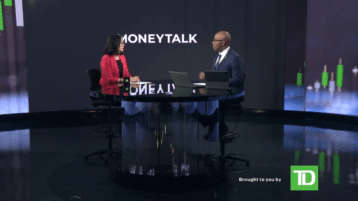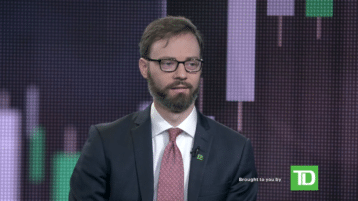Equity markets are off to a strong start this year, but those gains are being overshadowed by worries of a looming recession. Greg Bonnell speaks with Ben Gossack, Portfolio Manager at TD Asset Management, about what he sees in the markets going forward.
Print Transcript
[AUDIO LOGO]
It has been a moneymaking month for stocks, but we've also seen plenty of warnings from companies about potential pain ahead. Our next guest says investors may be missing the bigger picture if they're not looking beyond those negative headlines. Joining us now for more, Ben Gossack, Portfolio Manager at TD Asset Management. Ben, always a pleasure to have you here.
Great. Thanks for having me back.
So let's talk about the tone that we've seen in the markets. The first couple of days of 2023 were a bit rocky, but it's been a pretty decent start when you look back at the first month of the year. What do we need to be mindful of?
Yeah, I mean, we're basically at the end of January. We're about 5% up in the S&P 500. And I know people like to look at the investing based on solar calendars. So yes, 5% relative to the beginning of the year. I'd say we're still about 15% down from the highs that we last saw. I thought today we'd-- beginning of the year, kids talk about what they did over the holiday break. So I know it's still January. I'd talk about what I did over the holiday break.
You analyze charts.
I analyze charts. People went to Hawaii and traveled, but I thought I'd sit in front of the fire and analyze charts. And so you're right. There's still a bearish tone. We're finally getting bearish tone from management, taking down guidance and expectations, and there's still a bearish tone in terms of investor positioning. Having said that, what I did over the holidays, going through charts, I saw some interesting developments underneath, let's say, the S&P 500 or the TSX. One of the first ones that really surprised me was looking at homebuilders. If you read any newspaper, if you've been watching housing-- and that's something that's very personal for everyone-- the headlines couldn't be more atrocious. So in the US, they do 30-year mortgages. I think they peaked over 7%. They're still around 6 and 1/2%. So that's pretty expensive for the marginal mortgage. New home sales are down. Existing home sales, I think, have been contracting for the past 10 quarters. So it couldn't get any worse for housing. And yet when I look at housing stocks and companies that are in the housing sector, the worst it got for them, relative to the S&P 500, was March of 2022.
Really? That's almost a year ago.
It's almost a year ago. And if you recall, it's in March that the Fed starts their hiking cycle. Now, if you look at two-year rates, they had already imposed in tough financial conditions. So they were right at 2% when the Fed was just making their first set of hikes. But if you went long a homebuilder, if you went long a Home Depot, maybe a Lowe's, and you shorted the market, you would have an amazing, attractive return, even though the headlines are getting worse and worse. And what that's telling me is that we've factored in the slowdown. Now, caveat-- it could get worse. It doesn't mean that it's smooth sailing or I'm endorsing the housing sector. It just tells me that housing was one of the first to break, and it's one of the sectors that now have been improving against the market. And it's a bit of a reverse that we saw in 2021.
OK, so that's fascinating in the housing. You've got, I think, three more charts for us. What's the next one telling us? What do you want to show the audience?
Yeah, so the next one we move into is sort of a risk-on, risk-off indicator. So we talked about how the tone is negative in positioning in terms of what management is guiding to investors. And yet when we look at risk-off, risk-on indicators, it's indicating risk-on. One of the measures-- again, it's not prescriptive, but I look at the discretionary sector versus the staple sector. So we're a consumer-led economy, so I kind of look at this as the wants versus the needs. And one thing that I did in this particular chart is you have to look at the discretionary sector on a equal weight basis. If you take it as is, it's very dominated by Tesla and Amazon. And so the results that you're looking at, basically, is Tesla up or down, or is Amazon up or down? It won't tell you about discretionary as a whole. And so what we're looking at is discretionary versus staples. So if it's up and to the right, it means discretionary is outperforming. If the line is pulled down, it means staples are outperforming. And this aligns well with the market. And so you can see, there was a consolidation phase in 2022. But if this was a tug of war, at the beginning of this year, it pulls towards discretionary. And so we've seen staples underperform. We've seen retail come back. And they've borne through a lot of the headwinds. And it's coinciding with the tone that we're seeing in the market in terms of a plus 5% beginning of the year. I could do this for industrials versus staples. I'm seeing the same tone that risk-on is outperforming risk-off.
Yeah, very interesting. Let's get to the third chart right now. What do we want to show the audience, and what does it tell us?
Yeah, so I think this is-- it's about active and passive management. It's about how you're going to outperform the market. What we're looking at is a tug of war between the equal weight version of the S&P 500 versus the traditional S&P 500, which is weighted based on market cap. So companies like Apple and Microsoft are the bulk of the weighting inside the S&P 500. I'd say for-- I went back 10 years, so that's about a generation. So let's go back to 2013. This chart pulls to the bottom right, which means that the traditional market cap weighted S&P 500 has outperformed for almost 10 years. And so investors got very comfortable gravitating to passive ETFs because they were market cap. And then if you wanted to outperform that, you would just overweight the big market cap companies. And that's how we came up with monikers like FAANG. So it'd be Facebook, Amazon, Netflix, Google, and Apple. And so it didn't seem obvious, but in hindsight when we looked back, you just had to be more overweight, the largest companies in the index. And so what we've seen is a change in that trend, and that equal weight is outperforming market cap. And what that means, it's a big opportunity for stock picking. And so it does mean that you have to look beyond--
The passive ETF's not going to work like it used to work.
It doesn't mean that it can't work, but it is an opportunity now for active stock selection. So when I talk to our analyst team, they're very excited, and they've been proposing a ton of new ideas this year. But it's an opportunity for active managers to provide differentiation, show to clients, and justify their management fees. So I think this is an exciting time.
One more picture to show the audience. What have we got? What's the finale here?
OK, the coup de grace-- the final picture is the outperformance of the S&P 500 versus the rest of the world. So again, we're looking at a tug of war contest between the US markets and every other market. And so this has been probably the cleanest signal I've ever seen, which is up and to the right almost a 45-degree angle. Let's call it the last 10 years. You earned better returns on your dollars if you kept them in the US versus going after Canada, Europe, Asia. And again, it goes back to, large cap US companies are pretty much tech-dominated. And that's what most of these markets lacked in their country indices. And so there is a change in trend. And again, it coincides with that equal weight outperforming, and we'll see how long this trend persists. But especially for us in our global funds, the marginal dollar is going outside the US. It's going to Canada. It's going to Europe. It's going to Asia. There is a change in trend. And so if people looked at their global funds and said, why was it 80% US, it's because the US had just dominated for so many years.
So you put those four pictures together, what's the big takeaway for the audience?
I think when it comes to active stock selection, this is the year for managers to shine. And then put on top of that, what I'm really seeing within the market is there's opportunity. So it's very possible that the S&P 500, the TSX might be down this year as well, as it was last year. But having said that, underneath the market, there's opportunities. We've seen semiconductors bottom. We've seen biotechnology bottom. We've seen housing bottom. So many of the sectors that had crashed in '21 are starting to outperform. So the theme here would be opportunity. [AUDIO LOGO]
[MUSIC PLAYING]
It has been a moneymaking month for stocks, but we've also seen plenty of warnings from companies about potential pain ahead. Our next guest says investors may be missing the bigger picture if they're not looking beyond those negative headlines. Joining us now for more, Ben Gossack, Portfolio Manager at TD Asset Management. Ben, always a pleasure to have you here.
Great. Thanks for having me back.
So let's talk about the tone that we've seen in the markets. The first couple of days of 2023 were a bit rocky, but it's been a pretty decent start when you look back at the first month of the year. What do we need to be mindful of?
Yeah, I mean, we're basically at the end of January. We're about 5% up in the S&P 500. And I know people like to look at the investing based on solar calendars. So yes, 5% relative to the beginning of the year. I'd say we're still about 15% down from the highs that we last saw. I thought today we'd-- beginning of the year, kids talk about what they did over the holiday break. So I know it's still January. I'd talk about what I did over the holiday break.
You analyze charts.
I analyze charts. People went to Hawaii and traveled, but I thought I'd sit in front of the fire and analyze charts. And so you're right. There's still a bearish tone. We're finally getting bearish tone from management, taking down guidance and expectations, and there's still a bearish tone in terms of investor positioning. Having said that, what I did over the holidays, going through charts, I saw some interesting developments underneath, let's say, the S&P 500 or the TSX. One of the first ones that really surprised me was looking at homebuilders. If you read any newspaper, if you've been watching housing-- and that's something that's very personal for everyone-- the headlines couldn't be more atrocious. So in the US, they do 30-year mortgages. I think they peaked over 7%. They're still around 6 and 1/2%. So that's pretty expensive for the marginal mortgage. New home sales are down. Existing home sales, I think, have been contracting for the past 10 quarters. So it couldn't get any worse for housing. And yet when I look at housing stocks and companies that are in the housing sector, the worst it got for them, relative to the S&P 500, was March of 2022.
Really? That's almost a year ago.
It's almost a year ago. And if you recall, it's in March that the Fed starts their hiking cycle. Now, if you look at two-year rates, they had already imposed in tough financial conditions. So they were right at 2% when the Fed was just making their first set of hikes. But if you went long a homebuilder, if you went long a Home Depot, maybe a Lowe's, and you shorted the market, you would have an amazing, attractive return, even though the headlines are getting worse and worse. And what that's telling me is that we've factored in the slowdown. Now, caveat-- it could get worse. It doesn't mean that it's smooth sailing or I'm endorsing the housing sector. It just tells me that housing was one of the first to break, and it's one of the sectors that now have been improving against the market. And it's a bit of a reverse that we saw in 2021.
OK, so that's fascinating in the housing. You've got, I think, three more charts for us. What's the next one telling us? What do you want to show the audience?
Yeah, so the next one we move into is sort of a risk-on, risk-off indicator. So we talked about how the tone is negative in positioning in terms of what management is guiding to investors. And yet when we look at risk-off, risk-on indicators, it's indicating risk-on. One of the measures-- again, it's not prescriptive, but I look at the discretionary sector versus the staple sector. So we're a consumer-led economy, so I kind of look at this as the wants versus the needs. And one thing that I did in this particular chart is you have to look at the discretionary sector on a equal weight basis. If you take it as is, it's very dominated by Tesla and Amazon. And so the results that you're looking at, basically, is Tesla up or down, or is Amazon up or down? It won't tell you about discretionary as a whole. And so what we're looking at is discretionary versus staples. So if it's up and to the right, it means discretionary is outperforming. If the line is pulled down, it means staples are outperforming. And this aligns well with the market. And so you can see, there was a consolidation phase in 2022. But if this was a tug of war, at the beginning of this year, it pulls towards discretionary. And so we've seen staples underperform. We've seen retail come back. And they've borne through a lot of the headwinds. And it's coinciding with the tone that we're seeing in the market in terms of a plus 5% beginning of the year. I could do this for industrials versus staples. I'm seeing the same tone that risk-on is outperforming risk-off.
Yeah, very interesting. Let's get to the third chart right now. What do we want to show the audience, and what does it tell us?
Yeah, so I think this is-- it's about active and passive management. It's about how you're going to outperform the market. What we're looking at is a tug of war between the equal weight version of the S&P 500 versus the traditional S&P 500, which is weighted based on market cap. So companies like Apple and Microsoft are the bulk of the weighting inside the S&P 500. I'd say for-- I went back 10 years, so that's about a generation. So let's go back to 2013. This chart pulls to the bottom right, which means that the traditional market cap weighted S&P 500 has outperformed for almost 10 years. And so investors got very comfortable gravitating to passive ETFs because they were market cap. And then if you wanted to outperform that, you would just overweight the big market cap companies. And that's how we came up with monikers like FAANG. So it'd be Facebook, Amazon, Netflix, Google, and Apple. And so it didn't seem obvious, but in hindsight when we looked back, you just had to be more overweight, the largest companies in the index. And so what we've seen is a change in that trend, and that equal weight is outperforming market cap. And what that means, it's a big opportunity for stock picking. And so it does mean that you have to look beyond--
The passive ETF's not going to work like it used to work.
It doesn't mean that it can't work, but it is an opportunity now for active stock selection. So when I talk to our analyst team, they're very excited, and they've been proposing a ton of new ideas this year. But it's an opportunity for active managers to provide differentiation, show to clients, and justify their management fees. So I think this is an exciting time.
One more picture to show the audience. What have we got? What's the finale here?
OK, the coup de grace-- the final picture is the outperformance of the S&P 500 versus the rest of the world. So again, we're looking at a tug of war contest between the US markets and every other market. And so this has been probably the cleanest signal I've ever seen, which is up and to the right almost a 45-degree angle. Let's call it the last 10 years. You earned better returns on your dollars if you kept them in the US versus going after Canada, Europe, Asia. And again, it goes back to, large cap US companies are pretty much tech-dominated. And that's what most of these markets lacked in their country indices. And so there is a change in trend. And again, it coincides with that equal weight outperforming, and we'll see how long this trend persists. But especially for us in our global funds, the marginal dollar is going outside the US. It's going to Canada. It's going to Europe. It's going to Asia. There is a change in trend. And so if people looked at their global funds and said, why was it 80% US, it's because the US had just dominated for so many years.
So you put those four pictures together, what's the big takeaway for the audience?
I think when it comes to active stock selection, this is the year for managers to shine. And then put on top of that, what I'm really seeing within the market is there's opportunity. So it's very possible that the S&P 500, the TSX might be down this year as well, as it was last year. But having said that, underneath the market, there's opportunities. We've seen semiconductors bottom. We've seen biotechnology bottom. We've seen housing bottom. So many of the sectors that had crashed in '21 are starting to outperform. So the theme here would be opportunity. [AUDIO LOGO]
[MUSIC PLAYING]



























